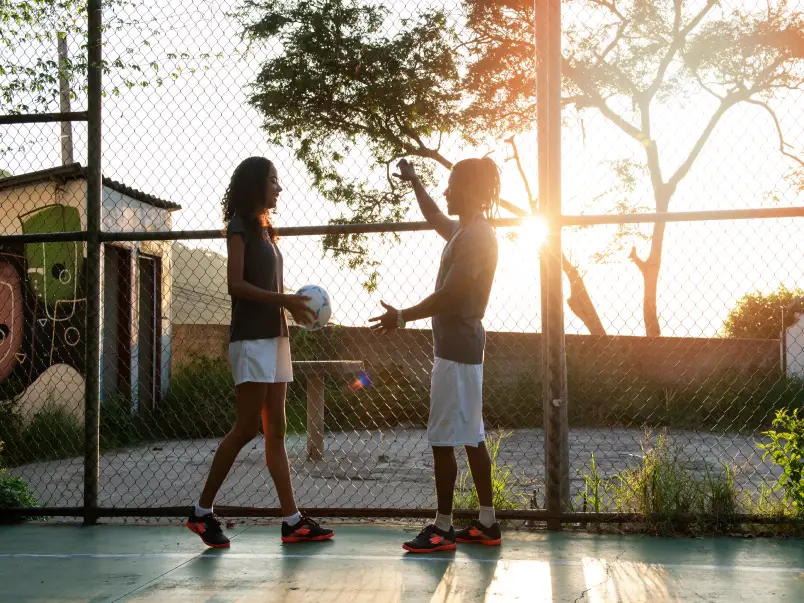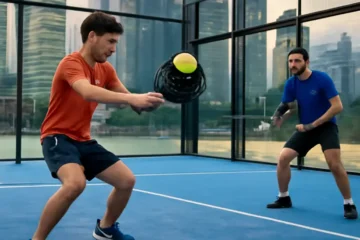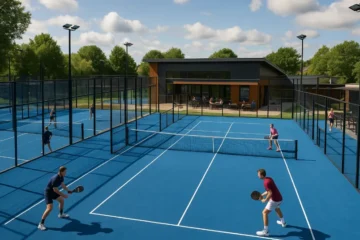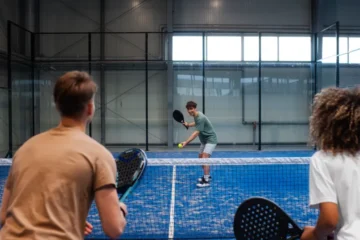Padel is no longer just a sport—it’s a global phenomenon. With its roots in Spain, padel has rapidly spread across Europe, South America, and beyond, transforming into one of the fastest-growing sports in the world. Its appeal lies in its accessibility and social nature. It’s fun, fast-paced, and great for players of all ages and skill levels. But as with any outdoor sport, the summer heat can pose a significant challenge. The combination of scorching temperatures, intense sun, and long daylight hours can turn the beloved padel courts into inhospitable spaces. However, innovative padel clubs around the world are stepping up to ensure the game remains enjoyable and safe, no matter how high the mercury climbs.
The Padel Boom Meets the Summer Sun
Padel’s explosive growth has created a global community that’s eager to play, practice, and compete in this thrilling sport. However, the rising temperatures during the summer months pose a serious threat to both player safety and the quality of the game. The traditional outdoor padel court is vulnerable to the sun’s relentless rays, which not only make the playing surface uncomfortably hot but also increase the risk of dehydration, heat exhaustion, and sunburn for players. Additionally, court availability becomes a challenge, with many players avoiding peak daytime hours due to extreme heat.
So, how are padel clubs keeping players on the courts during the hottest months? The answer lies in a multi-faceted approach that combines cutting-edge infrastructure with player-centric amenities and operational shifts. Let’s explore how forward-thinking padel clubs are adapting to beat the summer heat.
The Infrastructure Overhaul: Engineering Cooler Courts
Smarter Court Surfaces
One of the primary challenges for padel courts during summer is the high temperatures that build up on the playing surface. Traditionally, padel courts used dark-colored artificial turf, which absorbed heat, making the surface unbearably hot. To counteract this, many clubs have switched to lighter-colored artificial turf in shades like light blue, grey, and beige. These lighter hues reflect more sunlight, helping reduce the surface temperature by as much as 10-15°C. This simple change makes a huge difference in creating a more comfortable playing environment.
In addition to lighter-colored turf, many clubs are exploring advanced infill materials that help reduce heat retention. Traditional rubber granules, commonly used in artificial turf, absorb heat and retain it for hours after the sun sets. Newer silica-based infills are non-abrasive and retain significantly less heat, ensuring that the courts stay cooler for longer periods.
Creating Shade and Airflow
To complement the new court surfaces, padel clubs are also focusing on creating shade and maximizing airflow. Installing permanent canopies or retractable awnings over courts is becoming increasingly common. These structures provide direct protection from the sun and allow players to continue their games even during the hottest parts of the day.
Strategic landscaping is another smart solution. By planting trees and shrubs around the courts or designing windbreaks, clubs can encourage natural ventilation and cooling breezes, making the courts more pleasant to play on. This approach not only enhances the comfort of players but also reduces the reliance on mechanical cooling systems, which can be costly and energy-intensive.
Technological Interventions
The future of padel courts isn’t just about turf and shade—technology is playing a key role in combating the heat. One popular innovation is the installation of misting systems. These systems spray fine water mist around the perimeter of the court, lowering the ambient temperature without affecting the playing surface. The cooling effect is immediate and noticeable, making it much easier for players to keep their cool during intense rallies.
Another tech-forward solution is the use of high-performance LED lighting. With longer summer days, padel clubs are extending play into the evening hours. However, traditional lighting systems can generate significant heat. LED lights, on the other hand, burn cooler, offering bright, energy-efficient lighting without adding extra heat to the courts.
Operational Shifts: Rethinking the Playing Schedule
Embracing the “Summer Schedule”
With rising temperatures, traditional playing hours from late morning to early afternoon are no longer ideal for many players. To combat this, many padel clubs are shifting their playing schedules. The concept of “prime time” now extends to early mornings (6 AM – 10 AM) and late evenings (8 PM – Midnight). These cooler hours offer the best playing conditions, allowing players to enjoy their games without the oppressive heat.
In addition to rethinking peak hours, some clubs are embracing the “siesta model” by encouraging a midday break. Between 1 PM and 5 PM, many clubs reduce operating hours or offer discounts for off-peak bookings. This approach not only protects players from the heat but also allows the courts to cool down before evening sessions.
Dynamic Pricing and Incentives
To manage the heat and demand for cooler playing hours, some clubs are implementing dynamic pricing strategies. “Sunset & Sunrise” rates are offered for the most desirable early morning and late evening slots. This premium pricing ensures that clubs can maintain high usage rates during peak hours while balancing player comfort.
Meanwhile, “Heatwave Discounts” can help fill courts during midday hours when the temperatures are highest. These last-minute, reduced-rate bookings offer a win-win situation: players can enjoy the game at a discounted price, while clubs maximize court usage without compromising player safety.
Player-Centric Amenities and Wellness Focus
Hydration as a Priority
Keeping players hydrated is crucial in combating the summer heat. Many padel clubs are going beyond the standard bottled water offerings by providing free water refill stations, stocked with chilled water. This not only ensures that players stay hydrated throughout their sessions but also promotes sustainability by reducing plastic waste.
Additionally, electrolyte supplements like sports drinks and hydration sachets are increasingly available at clubs, either as part of membership perks or for purchase. These beverages help replenish vital minerals lost during intense physical activity and support optimal performance in the heat.
Cool-Down and Recovery Zones
After a hot game, players need an environment where they can cool down and recover. Many padel clubs are investing in air-conditioned lounges and clubhouses where players can rest between matches. These spaces offer a comfortable and cool escape from the summer heat, encouraging players to relax and socialize after their games.
For a more immediate post-match relief, cold towel stations are becoming a popular feature at many clubs. These stations provide chilled towels for players to cool their faces, necks, and arms after an intense session. Additionally, shaded seating areas are essential for those looking to recover in a comfortable, cool environment.
Education and Awareness
An important aspect of keeping players safe during summer play is educating them about heat-related risks. Clear signage reminding players to stay hydrated and to recognize signs of heatstroke is a simple but effective measure. Promoting the importance of wearing light-colored, moisture-wicking clothing, hats, and sunscreen is also critical in preventing heat-related illnesses.
Creative Programming and Events
Night Tournaments and Socials
With the cooler evening temperatures, padel clubs are now hosting “Midnight Padel” leagues and glow-in-the-dark tournaments. These fun, social events offer players a chance to enjoy the game in a vibrant, party-like atmosphere. The lights, music, and friendly competition create an exciting environment that attracts both competitive players and casual enthusiasts.
Focusing on Community and Social Spaces
For those times when it’s just too hot to play, many padel clubs are turning to non-sporting events to maintain community engagement. Clubhouses, bars, and restaurants are hosting workshops, networking events, and social gatherings, providing a cool and welcoming environment for members to connect, learn, and relax.
The Business Case: Why Adaptation is Essential
Player Retention
As temperatures rise, many players may cancel their memberships or take a break from the game. However, by offering a comfortable summer experience, padel clubs can reduce seasonal cancellations and retain their members year-round.
Safety and Liability
By implementing strategies to combat the heat, padel clubs are mitigating the risks associated with heat-related illnesses. This proactive approach not only ensures player safety but also reduces the club’s potential liability, protecting them from legal complications.
Maximizing Revenue
By extending playing hours and offering dynamic pricing, padel clubs can generate consistent revenue throughout the summer months. Filling courts during the heat of the day with discounted rates and high demand for cooler hours in the morning and evening helps maintain steady revenue flow.
Competitive Advantage
Adapting to the summer heat allows padel clubs to position themselves as modern, player-focused establishments. Clubs that prioritize player comfort and safety gain a competitive edge, attracting new members and retaining loyal ones.
A Cooler, Smarter Future for Padel
Padel clubs around the world are responding to the challenges posed by summer heat with innovative solutions that prioritize player safety, comfort, and enjoyment. From smarter court surfaces and shade structures to creative programming and wellness initiatives, these clubs are ensuring that the game continues to thrive, even during the hottest months.
Looking ahead, adapting to climate challenges will be essential for the sustainability of the sport. By embracing these changes, padel clubs can ensure that they remain vibrant, community-driven spaces that support players year-round—whether it’s under the scorching summer sun or the cool evening sky. The future of padel is bright, and it’s cooler, smarter, and more player-friendly than ever before.
FAQs
1. How are padel clubs addressing the summer heat?
Padel clubs are tackling the summer heat through a combination of infrastructure improvements, such as lighter-colored court surfaces, misting systems, and shading structures, alongside operational adjustments like revised playing schedules and hydration-focused amenities. These strategies ensure players remain safe and comfortable during summer play.
2. Why are lighter-colored court surfaces better for summer play?
Lighter-colored artificial turf reflects sunlight, significantly reducing the surface temperature. This makes the courts cooler and more comfortable for players, minimizing the risk of overheating and improving the overall playing experience.
3. What are “sunset and sunrise rates” in padel clubs?
“Sunset and sunrise rates” refer to premium pricing for the early morning (6 AM – 10 AM) and late evening (8 PM – Midnight) time slots when the temperatures are cooler. These adjusted pricing strategies help padel clubs manage demand during the most comfortable playing hours.
4. Are padel clubs using technology to combat the heat?
Yes, many padel clubs are incorporating technology such as misting systems that cool the air around the court and high-performance LED lights, which burn cooler and offer better visibility without adding extra heat. These tech solutions help maintain a comfortable environment for players.
5. What wellness programs do padel clubs offer during the summer?
To support player health in the summer, padel clubs provide free water refill stations, electrolyte supplements, cold towel stations for cooling off, and air-conditioned lounges. These amenities ensure players stay hydrated and recover effectively after games.
6. What is the “siesta model” in padel clubs?
The “siesta model” encourages clubs to close or offer discounts during the hottest part of the day (1 PM – 5 PM) when it’s unsafe or uncomfortable to play. This allows players to take a break while ensuring courts are used at cooler times, such as early mornings or late evenings.
7. How do padel clubs ensure player safety during heatwaves?
Padel clubs implement heat safety signage, educate players on recognizing heatstroke symptoms, and encourage proper attire, such as light-colored clothing, hats, and sunscreen. These measures help protect players from heat-related illnesses during intense summer sessions.
8. Can I still play padel during a heatwave?
Yes, many padel clubs adapt to heatwaves by offering discounts for off-peak hours, such as midday, and hosting evening events like glow-in-the-dark tournaments. These adjustments ensure players can enjoy the game safely, even during a heatwave.
9. How do creative events like “Midnight Padel” help padel clubs?
Events like “Midnight Padel” leagues and glow-in-the-dark tournaments provide an exciting, cooler alternative for players to enjoy the sport during the summer evenings. These social events also help boost engagement and maintain club membership during the hotter months.
10. What are the long-term benefits of adapting padel clubs to summer heat?
Adapting to summer heat ensures player retention, increases revenue by extending playing hours, and positions the club as a modern, player-focused business. These efforts not only improve player experience but also protect clubs from heat-related liability risks.




